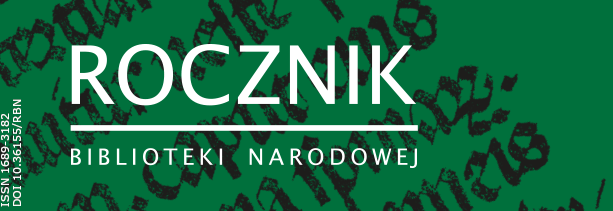NUMERY ARCHIWALNE

STRONA REDAKCYJNA, SPIS TREŚCI, s. 1–8 / CREDITS, TABLE OF CONTENTS, p. 1–8
STUDIA I MATERIAŁY / STUDIES AND MATERIALS
Katalogowanie przedmiotowe druków ulotnych z wykorzystaniem Deskryptorów Biblioteki Narodowej, s. 11–32 / Subject cataloguing of ephemera using the National Library Descriptors, p. 11–32
This article is about two important events related to the cataloguing of ephemera. Firstly, the authors discuss the introduction of a new information and search language in the National Library of Poland in 2017, that is, the National Library Descriptors (DBN). Secondly, they describe the creation (in 2018) and the introduction (at the beginning of 2019) of a new, narrowed and more specific definition of ephemera. Both changes influence the methodology of cataloguing ephemera.
The first part of the article points out terminological problems and discusses the impact of the 2018 definition on cataloguing ephemera using DBN. Among other topics, the issue of form and genus/genre descriptors related to the definition of ephemera is raised. The use of this type of descriptors is indirectly related to the content and subject matter of ephemera.
The second part concerns the principles of indexing the specific subject matter of ephemera using various types of descriptors, suitable for indexing different types of important and crucial information related to the subject of the catalogued ephemera.
The third part presents examples of subject representation for selected types of ephemera: a poster from the interwar period, a leaflet from World War II, a poster from the Polish People’s Republic period, as well as a contemporary event program.Homo reminiscens – człowiek pamiętający w prozie współczesnej Stefana Żeromskiego, s. 33–52 / Homo reminiscens – the ‘remembering man’ in Stefan Żeromski’s contemporary prose , p. 33–52
The article concerns the relationship between memory and subjectivity, revealed in the characters appearing in Stefan Żeromski’s contemporary prose. It is centred on the creation of homo reminiscens, the ‘remembering man’. The text consists of fragments presenting memory as an ability both destructive and reintegrating subjectivity. It shows the role of memory approached by the writer in a conscious and literary manner.
Biblioteka Rady Stanu Królestwa Polskiego w okresie konstytucyjnym i nieznane źródła do jej dziejów, s. 53–79 / The Library of the Council of State of the Kingdom of Poland in the constitutional period and the unknown sources for its history, p. 53–79
The article deals with the unknown topic of the history of the library of the Council of State of the Kingdom of Poland (BRS) from its establishment in 1816 to 1830/1831. This work is based on files from the Central Archives of Historical Records and a fragment of the ‘Księża Misjonarze’ [Congregation of the Mission] fund from the Archdiocesan Archives of Warsaw (critically analysed at the end of the article). The process of creating the BRS is described (absorption of the library resources of the Council of State of the Duchy of Warsaw, as well as works from dissolved monasteries, from secular publishers, including the capital’s Congregation of Mission).
The nature of the BRS changed from legal and historical to a universal one through the implementation of the legal deposit law of 1819, anticipated by the director of the library – Ludwik Plater, who already in 1816 ordered the transfer of copies of all works printed in the Kingdom to the BRS. The article describes the staff, budget, equipment, catalogues, and purchasing policy, and mentions the existence of an unknown institution: Instytutu Dzieł Periodycznych [Institute of Periodical Works]. The BRS collections are belong to the University of Warsaw Library.Nie tylko Iłowajski: w kręgu podręczników do historii w gimnazjach państwowych Królestwa Polskiego w latach 1863–1905, s. 79–100 / Not only Ilovaysky: history textbooks in state gymnasiums in the Kingdom of Poland in the years 1863–1905, p. 79–100
The basic task of each European Empire in the 19th century was to prove its right to rule over the conquered territory, to emphasise the relationship between the ‘ruling’ and the conquered nation, and to determine the place of the latter in the history and the present of the state. Along with the process of modernisation, the importance of new ways of indoctrination was growing. Schools played a special role in this as intermediaries in the transmission of both imperial-dynastic and national ideology to all of the subjects. In the Russian Empire this duty was performed especially by history lessons.
The aim of the article is to analyse the content of selected history textbooks with particular emphasis on the works of Sergey Rozhdestvensky and Ivan Bellarminov, commonly used in the state gymnasiums in the Kingdom of Poland between 1864 and 1905. The author examines the narrative on Polish history, the threads supposed to justify Russia’s participation in the partitions of the Polish-Lithuanian Commonwealth, and the arguments proving the ‘necessity’ of incorporating Poland into the Russian state.Obraz Królestwa Polskiego w podręcznikach do geografii w gimnazjach państwowych Warszawskiego Okręgu Naukowego (1864–1915), s. 101–124 / The image of the Kingdom of Poland in geography textbooks in state gymnasiums of the Warsaw School District (1864–1915), p. 101–124
The aim of the article is to present a description of the Kingdom of Poland in geography textbooks used in state gymnasiums of the Warsaw School District in the period 1864–1915. When discussing school textbooks, the author is primarily interested in the issue of the location of the Vistula Land and its inhabitants on the mental maps of the Russian Empire. Therefore, the basic question is: what (according to the authors of the textbooks) determined the necessity of its belonging to Russia, to what extent Polishness was an important part of its identity and what role were played by other, non-Polish ethnic groups. The analysis focuses on various interpretations of the Kingdom of Poland as a Russian periphery. According to the above-mentioned authors, ‘Russian Poland’ was described as (1) the successor of the historical Polish–Lithuanian Commonwealth, (2) the most developed area of the Russian Empire, (3) a territory of key strategic importance, (4) a peripheral area constituting the western continuation of the great East European Plain determining the specificity of the Russian Empire, (5) one of the most valuable areas of the Russian Empire, representing its „Europeanness”, and finally, after 1905, (6) a separate and specific historical and cultural entity. Regardless of these interpretations, in most cases Polishness was treated as one of the elements of the ethnic and cultural mix, while Russian signs of domination were to constantly remind of the subordination of this area to the Russian empire.
RECENZJE I SPRAWOZDANIA / REVIEWS AND REPORTS
Kilka słów o tym jakie można popełnić błędy, opisując polonika w zbiorach zagranicznych. Na marginesie publikacji: Polonika ze zbiorów Petersburskiego Instytutu Historii Rosyjskiej Akademii Nauk w Sankt Petersburgu: Sekcja Zachodnioeuropejska, t. 1–3, Białystok 2019, s. 125–142 / A few words about what mistakes can be made when describing Polonica in foreign collections. Review of: Polonika ze zbiorów Petersburskiego Instytutu Historii Rosyjskiej Akademii Nauk w Sankt Petersburgu: Sekcja Zachodnioeuropejska, vol. 1–3, Białystok 2019, p. 125–142
Kurs językowy dla uchodźców z Ukrainy w 2022 roku, s. 143– 145 / A language course for refugees from Ukraine in 2022, p. 143– 145

